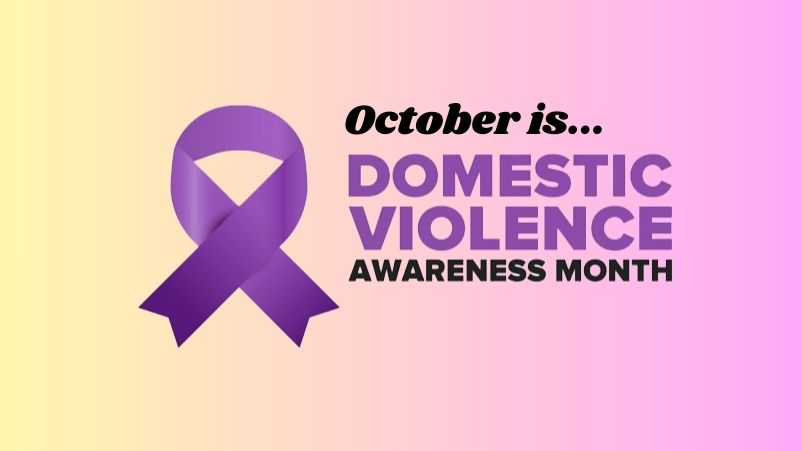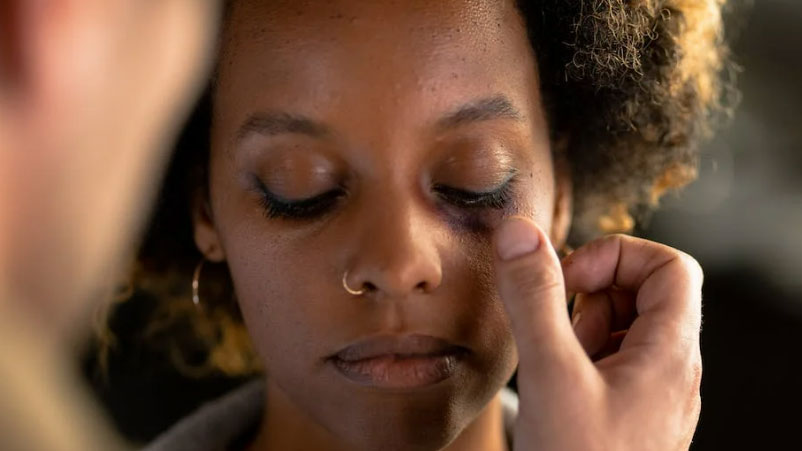Domestic Violence Awareness Month

October 26th
2023

Heal, hold, center: these three words make up the theme of this year’s Domestic Violence Awareness Month, which takes place every October in the U.S. “Heal” calls for us as a society to combat abuse and oppression, “hold” encourages us to acknowledge and support survivors, and “center” compels us to bring hidden stories of domestic violence out of the darkness and into the light. Many such stories have touched the lives of people from all backgrounds, including Co-parenting families. To honor its importance, we dedicate this post to raising awareness of domestic violence. Read on to learn more about how you can heal, hold, and center.
The Gist
Domestic Violence Awareness Month takes place every October to raise awareness of abuse and promote proactive strategies for healthier relationships.
Domestic violence can include physical, verbal, emotional, and sexual abuse against an intimate partner or family member. It can also include stalking and harassment. Perpetrators use domestic violence as a means to exert power and control over victims.
Domestic violence has been cited as a cause of 23.5% of divorces. A relationship breakup can also be an instigator for domestic violence. When domestic violence has occurred, the transition to co-parenting may be more difficult or drawn out, with higher levels of conflict.
Domestic violence can have serious, lifelong consequences. If you or someone you know has experienced domestic violence, seek support. You can also contribute to the cause by donating, becoming an advocate, learning more about the issue, and educating your child about healthy relationship dynamics.
Domestic Violence, Past and Present: A Persistent Problem Throughout History
The first Domestic Violence Awareness Month was held in October 1987, but domestic violence itself has been a problematic trend throughout history. The Office on Violence Against Women defines domestic abuse as a pattern of abusive behavior used to gain power and control over another person with whom one is in an intimate relationship. It is commonly called intimate partner violence (between current or former romantic partners, spouses, etc.) but can also include violence toward a family member (such as in the case of elder abuse). The violence can take many forms, including physical, verbal, emotional, and sexual abuse, harassment, stalking, coercion, and technological abuse.
Violence has been perpetrated in relationships for centuries, particularly against women, children, and other marginalized populations. In fact, it was often considered an acceptable and even preferred means of discipline and punishment in many parts of the world.
Over time, cultural values began to shift, leading to the enactment of laws and policies to protect against domestic abuse. In 1978, the National Coalition Against Domestic Violence (NCADV) was established, and in 2000 and 2005 the government finally passed two significant acts of legislation, The Violence Against Women Acts. These groundbreaking changes (among others) reinforced the basic human right to live free from physical, sexual, or emotional abuse. But unfortunately, they did not eradicate the perpetration of domestic violence altogether.
Current statistics show that domestic violence continues to be prevalent, across all genders, races, religions, and socioeconomic backgrounds.
- According to the CDC, 1 in 3 women and 1 in 4 men report severe domestic violence in their lifetime, 1 in 5 women and 1 in 13 men report sexual violence, and 14% of women and 5% of men report being stalked by an intimate partner. The CDC also finds that 50% of female homicide victims were killed by a current or former male intimate partner.
- According to the NCADV, more than 10 million adults experience domestic violence annually, which roughly equates to 1 every 3 seconds. From 2016 through 2018, the number of incidences of intimate partner violence increased by 42%. Domestic violence hotlines nationwide typically receive over 19000 calls per day.
The Covid Effect:
The Covid-19 pandemic upended the lives of families everywhere in ways that we are just beginning to examine. Social distancing and quarantine regulations meant different things for different people; for some, they allowed for more quality time at home and made people feel closer to their significant others and family members than ever before. But for many, this period of isolation, along with physical and financial concerns, created additional stress and mental health issues. The specific effects on domestic violence are not yet clear; however, preliminary evidence does suggest the following:
- Pandemic-related feelings of loneliness, depression, anxiety, stress, grief/loss, etc. may have been damaging to our mental health. In turn, mental health struggles have been known to trigger perpetrators to commit acts of violence against their partners. They may also make it harder for victims to assert themselves or take action against their abusers.
- Financial, housing, job, and food insecurities may have discouraged victims from leaving an abusive home situation.
- Social distancing, quarantine, and the shutdown of many services may have limited the resources available to people in crisis.
- Reports of domestic violence have increased all over the world. Our statistical information is still limited in the U.S. but upward trends have emerged. Examples include: 22% increase in domestic violence arrests in Portland, 18% increase in family violence calls to the police department in San Antonio and 27% in Jefferson County Alabama, and 10% increase in reports in New York City (Source)
Domestic Violence and Co-Parenting:

A noteworthy connection exists between domestic violence and parental separation or divorce. Many survivors go on to leave their partners; in fact, 23.5% of divorcing adults cite domestic violence as the cause ( Source ). Meanwhile, the end of a romantic relationship can be an especially vulnerable time for everyone in the family and can perpetuate the abuse. Abusers may be triggered toward additional violence, while victims may face fear, PTSD, or additional mental health issues. This negative dynamic can intensify in the aftermath of the breakup and lead to ongoing conflict, legal and custody battles, and stress for parents and children.
At KohParenting, we’ve often spoken of conflict in co-parenting as inevitable and workable because it truly can be! Many co-parents, even those who argued frequently prior to their separation, go on to find solutions and form a healthy, cooperative co-parenting relationship. However, a past history of domestic violence can potentially create a higher risk for parenting partners and their children, and recognizing this risk is critically important for the safety of everyone involved. If you or someone you know is in this situation, we strongly encourage you to seek professional help; contact 1-800-SAFE or The National Domestic Violence Hotline for more information.
- Physical threats or intimidation
- Verbal threats, name-calling, badmouthing the other parent, using derogatory language or tone
- Violating physical, personal, or emotional space
- “Digging” for information about dating activity or new romantic partners
- Excessive contact or “harassment” through phone, email, text, social media, etc.
- Refusing to follow the agreed-upon custody schedule, detaining the child as “punishment” to the other parent
- Unwanted or forced physical affection or contact
- Use of physical force
In keeping with this year’s theme, here are some suggestions for how you can get involved in the cause. For more ideas, check out our resource at the end of this post.
- Recognize the signs. Domestic violence is a pattern of behavior that emerges over time and isn’t always obvious to the naked eye. Familiarize yourself with the signs and symptoms so that you can intervene quickly. You can find NCADV’s comprehensive list here.
- Get help. Domestic violence threatens lives. Acts of violence can lead to death, and the physical and emotional impact of the trauma can diminish the quality of life for survivors. Professional support can break the cycle.
- Support survivors. Donate your time or money in support of survivors of abuse. Lend a hand or an ear to listen and validate their experiences, without judgment. Refrain from criticizing or blaming victims for choosing to stay with their abusers.
- Become an advocate. There are many ways to help, both on an individual and a systems level. For example, you could get trained to be a domestic violence advocate in the court system, or lobby and promote governmental policies in regard to supporting survivors. Contact a domestic violence agency in your area to find out more.
- Educate yourself and others. Domestic violence knows no specific age, gender, race, nationality, sexuality, etc. Seek information from reputable sources to learn the facts (see our list below).
- Educate your children on relationship dynamics. Eliminating violence in the future requires us to educate our youth about healthy relationships today. Start early by teaching your children about appropriate touch, consent, boundaries, etc. Continue the conversation throughout the developmental stages, especially when they begin dating. Talk about healthy versus unhealthy relationships and establish open lines of communication so that they can turn to you when they need help.
Violence Has No Place In the Home:
Intimate partner violence touches all of us, and we can all be part of the solution. We hope you’ll join us this month in promoting awareness of domestic violence by sharing this blog and posting in honor of #heal, #hold, #center on social media. At KohParenting, we’ll continue this mission year-round, because violence has no place in healthy co-parenting.
Does your child constantly challenge you? We have some surprising information to share on why this might not be such a “bad” thing! Stay tuned as we discuss this further in our next post.
Join our community where you can stay informed on what's happening in the world of co-parenting and learn more about what we do.
- The Nation's Leading Grassroots Voice on Domestic Violence (ncadv.org)
- SC-DVAM-Somebody-You-tKnow-Toolkit.pdf (sccadvasa.org)
- https://www.psychologytoday.com/us/blog/the-intelligent-divorce/201112/violence-in-divorce-towards-safety
- https://www.respondinc.org/dv-facts-stats/
- https://www.justice.gov/ovw/domestic-violence
- https://www.domesticshelters.org/articles/ending-domestic-violence/8-ways-to-help-a-victim-of-domestic-violence
- https://ncadv.org/signs-of-abuse

Loading
Thank you for joining our
Koh-Parenting Community!
We are registering your email address. Please don't leave this page. You will be redirected in less than 10 seconds.
To continue reading this blog, join our community!
When you join our community you will keep you in the loop on the latest co-parenting topics, our weekly Newsletter, company updates and happenings. We will be here every step of the way as you embark on a developing a healthier co-parenting relationship.
Latest Posts

We’ve Just Separated; Now What?” Series, Part II: Defining the New Relationship
What happens to the dynamic between two people when a relationship ends? After a breakup, many people completely remove [...]

We’ve Just Separated; Now What?” Series, Part I: What is Co-Parenting?
Are you stepping into 2024 as a newly minted co-parent? You’re not alone: statistically, the first Monday after New Ye[...]

Giving Back to YOU: Why Celebrating Your Co-Parenting Wins is the Ultimate Gift to Yourself
When was the last time you celebrated yourself? Many people spend the last few weeks of the year running around, buying [...]

KohParenting’s Top 3 Holiday Spending Pitfalls, Solved!
The ads are everywhere: ‘tis the season for spending! Retailers big and small all jump on the bandwagon at holiday tim[...]

7 Ways Single Parents Can Manage Holiday Stress
Any parent knows that the holidays can be full of both magic and mayhem. For single-parent families, the period from Tha[...]

Raising Kind Kids: World Kindness Week!
Kindness isn’t just a world; it’s a movement. Did you know that November 13th -19th is World Kindness Week? People f[...]

Celebrate With Us: A Year of the Best in Koh-Parenting Content
Co-parenting is one of the most challenging roles anyone could possibly undertake, and it’s important to celebrate all[...]
